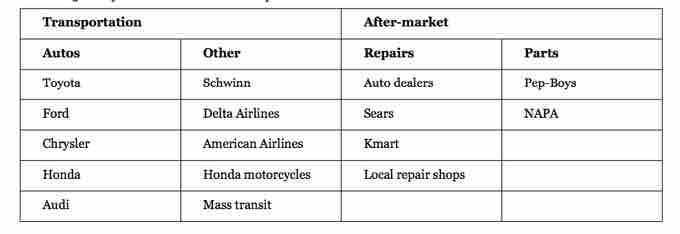Competitive Analysis
Competitive analysis focuses on opportunities and threats that may occur because of actual or potential competitive changes in strategy. Competitive analysis starts with identifying current and potential competitors. For example, who are General Motors' competitors? If you named companies like Toyota, Ford, Chrysler, and Honda, you are right, but you have just begun. outlines some of General Motors' competitors, and outlines some of Nintendo's competitors.

Competitor Analysis: Nintendo
An analysis of Nintendo's competitors

Competitor Analysis: General Motors
An analysis of General Motors' competition.
It is essential that the marketer begin the analysis by answering the following question: "What criteria can be used to identify a relevant set of competitors? " It is clear from the two examples above that an accurate accounting of competitors is much broader than the obvious. If competitors are defined too narrowly, there is a risk that an unidentified competitor will take market share away without the company's knowledge. A company's strategy must address all competitors, not just the leaders in a field. Competition is a never ending challenge that must be addressed on an ongoing basis because consumers are exposed to many types of products, to many different marketing concepts which, if compelling enough will prompt them to switch and make different choices on the products or services they buy.
For example, General Motors competes against Ford, Chrysler, Toyota, and other auto manufacturers. They also compete against Sears in the repair market, the subway in large cities, airlines, and Schwinn, among people for whom bicycle riding is popular. Nintendo competes against Sega in the video game market. It also competes against Blockbuster Video, local gyms, board games, the theater, and concerts. Competition focuses on individuals' wants and needs being satisfied, not the product being produced. General Motors, then, is competing to satisfy the public's need for transportation. Nintendo is competing to satisfy the need for entertainment.
Once competitors are correctly identified, it is helpful to assess them relative to factors that drive competition: entry, bargaining power of buyers and suppliers, existing rivalries, and substitution possibilities. These factors relate to a firm's marketing mix decisions and may be used to create a barrier to entry, increase brand awareness, or intensify a fight for market share. Barriers to entry represent business practices or conditions that make it difficult for new or existing firms to enter the market. Typically, barriers to entry can be in the form of capital requirements, advertising expenditures, product identity, distribution access, or switching costs.
In industries such as steel, automobiles, and computers, the power of buyers and suppliers can be very influential. Powerful buyers exist when they are few in number, there are low switching costs, or the product represents a significant share of the buyer's total costs. This is common for large retailers such as Walmart and Home Depot. Existing competitors and possible substitutes also influence the dynamics of the competition. For example, in slow-growth markets, competition is more severe for any possible gains in market share. High fixed costs also create competitive pressure for firms to fill production capacity. For example, hospitals are increasing advertising budgets in a battle to fill beds, which represents a high fixed cost.
The International Competitive Environment
Entering an international market is similar to doing so in a domestic market, in that a firm seeks to gain a differential advantage by investing resources in that market. Often local firms will adopt imitation strategies, sometimes successfully.